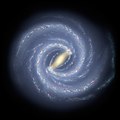Magellanic Bridge
 Stars being pulled from the SMC, heading towards the LMC, as seen by Gaia. | |
| Object type | H I region |
|---|---|
| 03h 11m | |
| Declination | −73.5° |
| Mass | (3–5)×105 M☉ |
| Estimated age | 0.2–1.5 Gyr |
The Magellanic Bridge (MBR)[1] is a stream of low density neutral Hydrogen (HI) that links the two Magellanic Clouds,[2] with a few known stars inside it. Though the stream is low density, it is still capable of star formation. The entire stream has a mass of (3–5)×105 M☉.[3][4]
The Magellanic bridge is probably between 200 million to 1.5 billion years of age based on the metallicity of the oldest stars in the region and N-body models.[5]
It should not be confused with the Magellanic Stream, which links the Magellanic Clouds to the Milky Way. It was discovered in 1963 by J. V. Hindman et al.[6]
Stars
[edit]There is a continuous stream of stars throughout the Magellanic Bridge linking the Large Magellanic Cloud (LMC) with the Small Magellanic Cloud (SMC). This stellar bridge is of greater concentration in the western part, representing bright young stars that don't travel very far in their short lifetimes, born from primordial-like gas in Star Formation Regions that have been pulled and become unbound ("tidally stripped")[7] from the weaker gravitational field of the SMC. There are two major density clumps, one near the SMC, the other midway between the galaxies, referred to as the OGLE Island.[1]
O-type stars have been discovered in the Magellanic Bridge.[7] Theses stars have been shown to have low Iron abundances in a metallicity regime comparable to the dwarf galaxies of Sextans A and Leo P.[8]
References
[edit]- ^ a b SpaceDaily, "Polish astronomers spot young Stellar Bridge in the Magellanic Clouds", 28 November 2014
- ^ Putman, M. E. (2013). "The Magellanic System's Interactive Formations". Publications of the Astronomical Society of Australia. 17 (1): 1–5. Bibcode:2000PASA...17....1P. doi:10.1071/AS00001.
- ^ Lehner, N. (2001). "FUSE Observations of the Magellanic Bridge". Bulletin of the American Astronomical Society. 33: 1408. Bibcode:2001AAS...199.6506L.
- ^ Lehner, N. (2002). "Far-Ultraviolet Spectroscopic Explorer Observations of the Magellanic Bridge Gas toward Two Early-Type Stars: Molecules, Physical Conditions, and Relative Abundances". The Astrophysical Journal. 578 (1): 126–143. arXiv:astro-ph/0206250. Bibcode:2002ApJ...578..126L. doi:10.1086/342349. S2CID 118633204.
- ^ Oliveira, R A P.; Maia, F F S.; Barbuy, B.; Dias, B.; Santos, J F C.; Souza, S. O.; Kerber, L. O.; Bica, E.; Sanmartim, D.; Quint, B.; Fraga, L.; Armond, T.; Minniti, D.; Parisi, M. C.; Katime Santrich, O. J.; Angelo, M. S.; Pérez-Villegas, A.; De Bórtoli, B. J. (2023). "The VISCACHA survey – VII. Assembly history of the Magellanic Bridge and SMC Wing from star clusters". Monthly Notices of the Royal Astronomical Society. 524 (2): 2244–2261. arXiv:2306.05503. doi:10.1093/mnras/stad1827.
- ^ Harris, Jason (2007). "The Magellanic Bridge: The Nearest Purely Tidal Stellar Population". The Astrophysical Journal. 658 (1): 345–357. arXiv:astro-ph/0612107. Bibcode:2007ApJ...658..345H. doi:10.1086/511816. S2CID 12948593.
- ^ a b Ramachandran, Varsha; Oskinova, L. M.; Hamann, W.-R. (2021). "Discovery of O stars in the tidal Magellanic Bridge". Astronomy & Astrophysics. 646: A16. arXiv:2011.08006. Bibcode:2021A&A...646A..16R. doi:10.1051/0004-6361/202039486.
- ^ Schösser, E. C.; Ramachandran, V.; Sander, A. a. C.; Gallagher, J. S.; Bernini-Peron, M.; González-Torà, G.; Josiek, J.; Lefever, R. R.; Hamann, W.-R.; Oskinova, L. M. (2025-04-01). "Extremely iron-poor O-type stars in the Magellanic Bridge". Astronomy & Astrophysics. 696: L3. arXiv:2503.10769. doi:10.1051/0004-6361/202554027. ISSN 0004-6361.
External links
[edit]- SIMBAD, "Magellanic Bridge" (accessed 12 April 2010)
